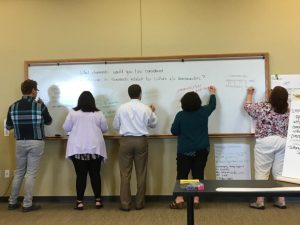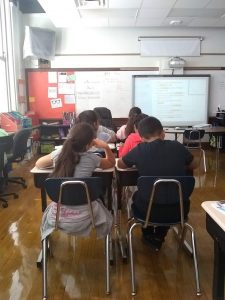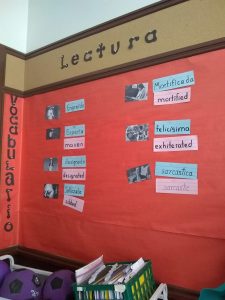Field Trip: Castelar Elementary, Omaha Public Schools


 This is the beginning of a special series in which the World Language Specialist will visit, by invitation, schools in Nebraska to explore world language options.
This is the beginning of a special series in which the World Language Specialist will visit, by invitation, schools in Nebraska to explore world language options.
A couple of blocks down the hill from the small, gold-domed Ukrainian Church of the Assumption sits Castelar Elementary. Built in 1899, it was the neighborhood school to Italian immigrants. Nearly 120 years later, this south Omaha school has been reborn many times, always as a haven for a global student body. In 2002, Castelar joined Omaha’s growing Dual Language Immersion program. Yet again, the school is over capacity in enrollment. This time, there is a waiting list to attend.
Maria Perez-Mozaz, the Dual Language Facilitator for Castelar Elementary, led me on a tour of the historic facility. Perez-Mozaz came to Omaha many years ago as a visiting teacher sponsored by the Nebraska Department of Education. Her deep appreciation for her adopted home is as apparent as the fine tailoring of her well cut suit. She is both congenial and consummately professional as so many of her colleagues. As we walked through the historic building, I observed signs and student work in both Spanish and English neatly tacked above the tidy lockers. Perez-Mozaz provided the history of Dual Language Immersion.
Dual Language Immersion was initiated by Omaha Public Schools in 2000 as a way of closing the achievement gap for English language learners. OPS now offers dual language immersion (DLI) in six elementary schools, three middle schools, and one high school. Within those schools are “strands” for students enrolled in the DLI option. For each grade level, there is a Spanish side teacher and an English side teacher. Both teachers teach all content areas. In each elementary strand, students spend 50% of the day in
Spanish and 50% of the day in English. This week, Kindergarten is completing writing course work in Spanish. Next week, they will complete writing course work in English.
Content is never repeated; it continues from the point that the class reached in the other language. Students are held accountable to benchmarks in both languages.
The benefits to students is significant. OPS saw that gaps in reading, math, and science closed quickly for DLI students. On the now defunct state standardized test, DLI high school students out-performed their peers consistently. Attendance, behavior, and academic achievement is significantly higher for DLI students at all levels. DLI students at South have a graduation rate of over 90% and in some years reaching the goal of 100%. South High Magnet School has seen steady gains in achievement and had the highest number of University of Nebraska at Omaha enrollees in the fall of 2017.
Katy Cattlett, Supervisor of Dual Language and World Language Instruction, commented that dual language education changes the mindset of parents and students. Most of all it changes the mindset of teachers. The expectation is now about making plans for post-secondary education.
If these statistics may not seem notable yet, this is an underdog story. Many of these students come from immigrant homes. Their parents do not speak English. At Castelar, 92% of the student body qualifies for free and reduced lunch. 89.9% of the school population is Hispanic. 61.8% of the students qualify for English Language Learner services. Fifteen percent of the students have tested out of the required EL services but do speak another language at home. Five percent of the students who qualified for EL opted to waive EL placement. In all, 81.8% of the student body are not native English speakers.
They are not, however, all Spanish speakers. Castelar, like many OPS schools, has a growing Central American population. Many students from Guatemala speak Q’anjobal at home. Several of these students have not had formal education. The act of attending school and understanding the social and academic requirements can be a learning curve.
Castelar staff reach out to parents to help with the transition. Monthly chats are held to review information and resources in both Spanish and English. Castelar Principal Adriana Vargas appreciates the strong partnerships with the Henry Doorly Zoo, the Durham Museum, Lauritzen Gardens and Brookside Church. Brookside continues to offer a care center with reduced cost clothing, coat drives, and a carnival. The Learning Community also helps by reaching out to parents of prekindergarten students to offer three years of English language learning for parents.
The district, surprisingly, does not see an undue cost burden for DLI schools. The dual language programs were placed at schools with a high population of English learners. Due to the needs of the population, each school had several teachers of ELLs. A redesign of staffing replaced an ELL teaching position with a Dual Language Resource Teacher. Some of the existing regular classroom teaching positions were staffed with bilingual teachers who now teach in Spanish. OPS staffs these positions with Spanish-proficient teachers from the Nebraska, out-of-state recruitments, and international visiting teachers. As the program has aged, OPS is finding new teachers in its alumni groups.
Astoundingly, OPS Dual Language Immersion gets little recognition in Nebraska. Three Nebraska school districts that have sought counsel and resources from OPS in order to start their own programs. However, many outside of Omaha are unfamiliar with the DLI concept. Last year, Castelar was recognized for the second time as a finalist for the Elementary School of the Year award by the International Spanish Academy, sponsored by the Ministry of Education of Spain. South Magnet High School was honored as the high school of the year. While Omaha is the largest city in the state, it is not the only city with ethnic and national diversity in Nebraska.
In 2016, Nebraska was the state receiving the greatest number of refugees per capita. Nebraska has welcomed refugees since the 1960s from places such as Vietnam, Bosnia, Serbia, Croatia, Somalia, Syria, Cuba, and Burma. The cities of Bellevue, Crete, Grand Island, Hastings, Lexington, Lincoln, Schuyler, and Scottsbluff are among those receiving refugees. Certainly, there is a need for supporting ELLs.
Meanwhile, OPS continues to expand DLI instruction. Three years ago, Castelar had an internal waiting list of over 250 students already in the school but wishing to be included in the DLI program. Last year, Castelar began a new strand of DLI for Kindergarten. The second strand is now in first grade and next year second grade will be added by repurposing a traditional English classroom to a Spanish classroom. This year, 320 of the 660 Castelar students are in the DLI program.
Maria Perez-Mozaz certainly hopes the program will continue. In every classroom we enter, she can point to a child and tell me the academic history and recent benchmarks the child has met. Students know her and she stops periodically to accept a hug, give a high five, or ask a student—in Spanish—about the materials that are on the table. While she has copious quantitative data clearly defining the success of this program, her real indicators are here in the high ceiling, sun-lit classrooms of Castelar.


